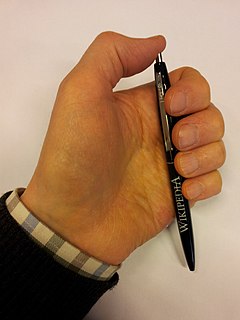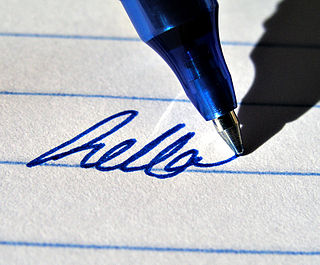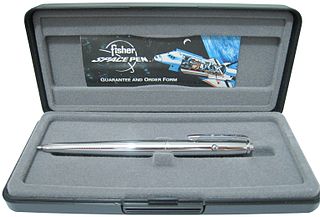 W
WA ballpoint pen, also known as a biro or ball pen, is a pen that dispenses ink over a metal ball at its point, i.e. over a "ball point". The metal commonly used is steel, brass, or tungsten carbide. The design was conceived and developed as a cleaner and more reliable alternative to dip pens and fountain pens, and it is now the world's most-used writing instrument; millions are manufactured and sold daily. It has influenced art and graphic design and spawned an artwork genre.
 W
WA ballpoint pen knife is a multi-tool pocket knife consisting of a blade concealed inside an ordinary-looking ballpoint pen. The blade, typically 51 to 127 millimetres in length, is usually hidden. They first appeared as custom-made pens from various custom knife makers before being mass-produced by production companies.
 W
WThe Bic Cristal is an inexpensive disposable ballpoint pen mass-produced and sold by Société Bic of Clichy, Hauts-de-Seine, France. It was introduced in December 1950 and is the best-selling pen in the world, with the 100 billionth sold in September 2006. It has become the archetypal ballpoint pen and is considered ubiquitous, to the extent that the Museum of Modern Art has made it a permanent part of its collection. Its hexagonal form and design mimics a standard pencil and it is sold in 6 types of point and 18 colours around the world.
 W
WLászló József Bíró or Ladislao José Biro was a Hungarian-Argentine inventor who patented the first commercially successful modern ballpoint pen. The first ballpoint pen had been invented roughly 50 years earlier by John J. Loud, but it did not attain commercial success.
 W
WDemonstrator pens are pens which are partially or mostly transparent.
 W
WA digital pen is an input device which captures the handwriting or brush strokes of a user and converts handwritten analog information created using "pen and paper" into digital data, enabling the data to be utilized in various applications. This type of pen is usually used in conjunction with a digital notebook, although the data can also be used for different applications or simply as a graphic.
 W
WA dip pen or nib pen or pen nib usually consists of a metal nib with capillary channels like those of fountain pen nibs, mounted in a handle or holder, often made of wood. Other materials can be used for the holder, including bone, metal and plastic; some pens are made entirely of glass.
 W
WErasermate is a pen product introduced by the Papermate division of the Gillette Company in 1979. The word Erasermate in and of itself has become known as the erasable pen of the Papermate product line.
 W
WFlo-Master was a brand of inks and markers in the latter half of the 20th century, remembered particularly for the colorful opacity of the inks. These markers were designed for marking on glass, and became weapons of choice among New York City writers of the Original School of NYC Writin' in the 1970s and early 1980s.
 W
WA fountain pen is a writing instrument which uses a metal nib to apply a water-based ink to paper. It is distinguished from earlier dip pens by using an internal reservoir to hold ink, eliminating the need to repeatedly dip the pen in an inkwell during use. The pen draws ink from the reservoir through a feed to the nib and deposits it on paper via a combination of gravity and capillary action. Filling the reservoir with ink may be achieved manually, via the use of an eyedropper or syringe, or via an internal filling mechanism which creates suction or a vacuum to transfer ink directly through the nib into the reservoir. Some pens employ removable reservoirs in the form of pre-filled ink cartridges.
 W
WA gel pen uses ink in which pigment is suspended in a water-based gel. Because the ink is thick and opaque, it shows up more clearly on slick surfaces than the typical inks used in ballpoint or felt tip pens. Gel pens can be used for many types of writing and illustration.
 W
WAn inkwell is a small jar or container, often made of glass, porcelain, silver, brass, or pewter, used for holding ink in a place convenient for the person who is writing. The artist or writer dips the brush, quill, or dip pen into the inkwell as needed or uses the inkwell as the source for filling the reservoir of a fountain pen. An inkwell usually has a lid to prevent contamination, evaporation, accidental spillage, and excessive exposure to air. A type known as the travelling inkwell was fitted with a secure, screw lid so a traveller could carry a supply of ink in their luggage without the risk of leakage.
 W
WA marker pen, fineliner, marking pen, felt-tip pen, flow marker, vivid, texta, sketch pen or koki, is a pen which has its own ink source and a tip made of porous, pressed fibers such as felt. A permanent marker consists of a container and a core of an absorbent material. This filling serves as a carrier for the ink. The upper part of the marker contains the nib that was made in earlier times of a hard felt material, and a cap to prevent the marker from drying out. Until the early 1990s, the most common solvents that were used for the ink were toluene and xylene. These two substances are both harmful and characterized by a very strong smell. Today, the ink is usually made on the basis of alcohols. Markers may be waterproof, dry-erase, wet-erase, or permanent.
 W
WMr. Sketch is a brand of scented markers, currently owned by Newell Brands. Its markers are sold in packages of 4, 6, 8, 10, 12 and 18 units. Mr. Sketch markers come in both chisel and fine point. The markers have large strokes and can be used for posters and group work. Mr. Sketch markers have many different colors to choose from.
 W
WA nib is the part of a quill, dip pen, fountain pen, or stylus which comes into contact with the writing surface in order to deposit ink. Different types of nibs vary in their purpose, shape and size, as well as the material from which they are made.
 W
WA pen is a common writing instrument used to apply ink to a surface, usually paper, for writing or drawing. Historically, reed pens, quill pens, and dip pens were used, with a nib dipped in ink. Ruling pens allow precise adjustment of line width, and still find a few specialized uses, but technical pens such as the Rapidograph are more commonly used. Modern types include ballpoint, rollerball, fountain and felt or ceramic tip pens.
 W
WThe Pen Museum is a museum in Birmingham, England, covering the history of Birmingham's steel pen trade. The only museum in the United Kingdom devoted to the history of the pen making industry, the Pen Museum explains how Birmingham became the centre of the world pen trade.
 W
WPen spinning is a form of object manipulation that involves the deft manipulation of a writing instrument with hands. Although it is often considered a form of self-entertainment, multinational competitions and meetings are sometimes held. It is sometimes classified as a form of contact juggling; however, some tricks do leave contact with the body. In addition to writing instruments, it is often also seen performed by drummers with their drumsticks. In fact, drumsticks are substantially easier to manipulate than pens, because of their extra mass and length. Pen spinning has quickly gained international popularity through online video sharing and forums. The pastime has been popular across the world since at least the 1970s.
 W
WA permanent marker or indelible marker is a type of marker pen that is used to create permanent or semi-permanent writing on an object. In general, the ink comprises a main carrier solvent, a glyceride, a pyrrolidone, a resin and a colorant, making it water resistant. It is capable of writing on a variety of surfaces from paper to metal to stone. They come in a variety of tip sizes, shapes, and colors. Like spray paint, these markers contain volatile organic compounds which evaporate to dry the ink. Due to compounds such as toluene and xylene often being present in permanent markers, they have a potential for abuse as a recreational drug.
 W
WA qalam is a type of pen made from a cut, dried reed, used for Islamic calligraphy. The pen is seen as an important symbol of wisdom in Islam, and references the emphasis on knowledge and education within the Islamic tradition.
 W
WA rastrum is a five-pointed writing implement used in music manuscripts to draw parallel staff lines when drawn horizontally across a blank piece of sheet music. The word "raster" is derived from the Latin for "rake". Rastra were used to draw lines on paper that had not been pre-ruled, and were widely used in Europe until printed staff paper became cheap and common in the nineteenth century. Some rastra are able to draw more than one staff at a time. Rastrology, the study of the use of the rastrum, is a branch of music manuscript studies that uses information about the rastrum to help find the date and provenance of musical materials.
 W
WA reed pen is a writing implement made by cutting and shaping a single reed straw or length of bamboo.
 W
WRetractable pens are a type of ink pen which have a spring-loaded ink cartridge which retracts and extends outside a protective housing. By clicking downward on the top of the pen, the tip is extended and locks in place at the bottom of the housing for use.
 W
WRoller ball pens or roll pens are pens which use ball point writing mechanisms with water-based liquid or gelled ink, as opposed to the oil-based viscous inks found in ballpoint pens. These less viscous inks, which tend to saturate more deeply and more widely into paper than other types of ink, give roller ball pens their distinctive writing qualities. The writing point is a tiny ball, usually 0.5 or 0.7 mm in diameter, that transfers the ink from the reservoir onto the paper as the pen moves.
 W
WA ruling pen is a drawing instrument for drawing with ink or with other drawing fluids.
 W
WThe Space Pen, marketed by Fisher Space Pen Company, is a pen that uses pressurized ink cartridges and is able to write in zero gravity, underwater, over wet and greasy paper, at any angle, and in a very wide range of temperatures.
 W
WA technical pen is a specialized instrument used by an engineer, architect, or drafter to make lines of constant width for architectural, engineering, or technical drawings. "Rapidograph" is a trademarked name for one type of technical pen. Technical pens use either a refillable ink reservoir or a replaceable ink cartridge.
 W
WAn ultraviolet (UV) marker is a pen whose marks are fluorescent but transparent: the marks can be seen only under an ultraviolet light. They are commonly used in security situations to identify belongings or to prevent the reproduction of unauthorized banknotes. UV pens can now be bought at some stationery shops to securely mark items of high value in case of theft.